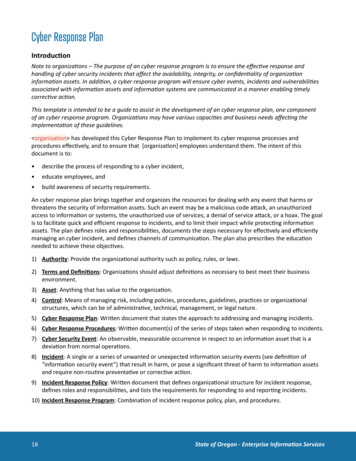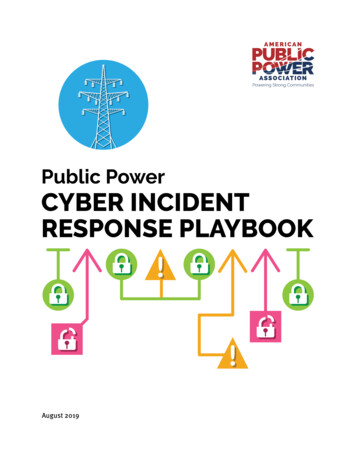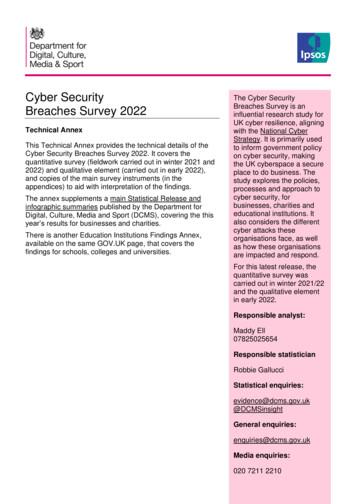
Transcription
Cyber Response PlanIntroductionNote to organizations – The purpose of an cyber response program is to ensure the effective response andhandling of cyber security incidents that affect the availability, integrity, or confidentiality of organizationinformation assets. In addition, a cyber response program will ensure cyber events, incidents and vulnerabilitiesassociated with information assets and information systems are communicated in a manner enabling timelycorrective action.This template is intended to be a guide to assist in the development of an cyber response plan, one componentof an cyber response program. Organizations may have various capacities and business needs affecting theimplementation of these guidelines. organization has developed this Cyber Response Plan to implement its cyber response processes andprocedures effectively, and to ensure that [organization] employees understand them. The intent of thisdocument is to: describe the process of responding to a cyber incident, educate employees, and build awareness of security requirements.An cyber response plan brings together and organizes the resources for dealing with any event that harms orthreatens the security of information assets. Such an event may be a malicious code attack, an unauthorizedaccess to information or systems, the unauthorized use of services, a denial of service attack, or a hoax. The goalis to facilitate quick and efficient response to incidents, and to limit their impact while protecting informationassets. The plan defines roles and responsibilities, documents the steps necessary for effectively and efficientlymanaging an cyber incident, and defines channels of communication. The plan also prescribes the educationneeded to achieve these objectives.1) Authority: Provide the organizational authority such as policy, rules, or laws.2) Terms and Definitions: Organizations should adjust definitions as necessary to best meet their businessenvironment.3) Asset: Anything that has value to the organization.4) Control: Means of managing risk, including policies, procedures, guidelines, practices or organizationalstructures, which can be of administrative, technical, management, or legal nature.5) Cyber Response Plan: Written document that states the approach to addressing and managing incidents.6) Cyber Response Procedures: Written document(s) of the series of steps taken when responding to incidents.7) Cyber Security Event: An observable, measurable occurrence in respect to an information asset that is adeviation from normal operations.8) Incident: A single or a series of unwanted or unexpected information security events (see definition of“information security event”) that result in harm, or pose a significant threat of harm to information assetsand require non-routine preventative or corrective action.9) Incident Response Policy: Written document that defines organizational structure for incident response,defines roles and responsibilities, and lists the requirements for responding to and reporting incidents.10) Incident Response Program: Combination of incident response policy, plan, and procedures.18State of Oregon - Enterprise Information Services
11) Information: Any knowledge that can be communicated or documentary material, regardless of its physicalform or characteristics, including electronic, paper and verbal communication.12) Information Security: Preservation of confidentiality, integrity and availability of information; in addition,other properties, such as authenticity, accountability, non-repudiation, and reliability can also be involved.13) Threat: A potential cause of an unwanted incident, which may result in harm to a system or the organization.Roles and ResponsibilitiesNote to organizations – These role descriptions here are an example. Organizations should adjust thesedescriptions as necessary to best meet their business environment and include any additional roles that havebeen identified in the organization that apply such as Security Officer, Privacy Officer, etc. Organizations needto identify roles, responsibilities and identify who is responsible for incident response preparation and planning,discovery, reporting, response, investigation, recovery, follow-up and lessons learned.Staffing will be dependent on organization’s capabilities. The same person may fulfill one or more of these rolesprovided there is sufficient backup coverage. The following are suggested roles and responsibilities organizationsshould consider: incident response team members, incident commander, and point of contact to interface withexternal organizations.1) Organizations Head Executive: Responsible for information security in the organization, for reducing riskexposure, and for ensuring the organization’s activities do not introduce undue risk to the enterprise. The Organizations Head Executive also is responsible for ensuring compliance with security policies, standards,and security initiatives, and with local, state and federal regulations.2) Incident Response Point of Contact: Responsible for communicating with external organizations andcoordinating organizations actions with external organizations in response to an information securityincident.3) Information Owner: Responsible for creating initial information classification, approving decisions regardingcontrols and access privileges, performing periodic reclassification, and ensuring regular reviews for valueand updates to manage changes to risk.User Responsible for complying with the provisions of policies, procedures and practices.ProgramDetail on organizations governance structure – identify who is responsible for managing cyber response for theorganization, who is responsible for developing policy, who is responsible for developing procedures, who isresponsible for awareness, identification of any governing bodies such as management committees and workgroups, etc.Include what cyber response capabilities the organization has or identify outside resource and their capabilities.Include how the organization will test plan and frequency. Include other related program areas such as businesscontinuity planning, risk management, and privacy as they relate to incident response.Note to organizations –Procedures may in include Incident Reporting Procedures for staff, management,information technology, and Point of Contact.Oregon Cyber Disruption Response & Recovery - Voluntary Resource Guide for Local Government19
The Incident Response Program is composed of this plan in conjunction with policy and procedures. Thefollowing documents should be reviewed for a complete understanding of the program:1) Organization Incident Response, Policy XXX-XX , located in Appendix insert appendix number at theend of this document.2) Organization Procedure: Cyber Response, located in Appendix insert appendix number at the end ofthis document. The related flowchart for this procedure is found in Appendix insert appendix number atthe end of this document.Cyber incidents will be communicated in a manner allowing timely corrective action to be taken. This plan showshow the organization will handle response to an incident, incident communication, incident response plantesting, training for response resources and awareness training.The Incident Response Policy, Plan, and procedures will be reviewed insert interval here, i.e. annually or ifsignificant changes occur to ensure their continuing adequacy and effectiveness. Each will have an owner whohas approved management responsibility for its development, review, and evaluation. Reviews will includeassessing opportunities for improvement and approach to managing cyber response in regards to integratinglessons learned, to changes to organization’s environment, new threats and risks, business circumstances,legal and policy implications, and technical environment.IdentificationIdentification of an incident is the process of analyzing an event and determining if that event is normal or ifit is an incident. An incident is an adverse event and it usually implies either harm, or the attempt to harm the organization . Events occur routinely and will be examined for impact. Those showing either harm or intent toharm may be escalated to an incident. Detail who is responsible for this step and the process that will be used The term “incident” refers to an adverse event impacting one or more organization’s information assets or tothe threat of such an event. Examples include but are not limited to the following: Unauthorized useDenial of ServiceMalicious codeNetwork system failures (widespread)Application system failures (widespread)Unauthorized disclosure or loss of informationInformation Security BreachOtherIncidents can result from any of the following: 20Intentional and unintentional actsActions of employeesActions of vendors or constituentsActions of third partiesExternal or internal actsCredit card fraudPotential violations of organization’s PoliciesNatural disasters and power failuresActs related to violence, warfare or terrorismSerious wrongdoingState of Oregon - Enterprise Information Services
OtherIncident ClassificationOnce an event is determined to be an incident, several methods exist for classifying incidents. Detail who is responsible for this step and the process that will be used The following factors are considered when evaluating incidents: Criticality of systems that are (or could be) made unavailableValue of the information compromised (if any)Number of people or functions impactedBusiness considerationsPublic relationsEnterprise impactMulti-agency scopeTriageThe objective of the triage process is to gather information, assess the nature of an incident and begin makingdecisions about how to respond to it. It is critical to ensure when an incident is discovered and assessed thesituation does not become more severe. Detail who is responsible for this step and the process that will be used What type of incident has occurredWho is involvedWhat is the scopeWhat is the urgencyWhat is the impact thus farWhat is the projected impactWhat can be done to contain the incidentAre there other vulnerable or affected systemsWhat are the effects of the incidentWhat actions have been takenRecommendations for proceedingMay perform analysis to identify the root cause of the incidentEvidence PreservationCarefully balancing the need to restore operations against the need to preserve evidence is a critical part ofincident response. Gathering evidence and preserving it are essential for proper identification of an incident,and for business recovery. Follow-up activities, such as personnel actions or criminal prosecution, also rely ongathering and preserving evidence. Detail who is responsible for this step and the process that will be used ForensicsNote to organizations – in cases involving potential exposure of personally identifiable information it isrecommended that technical analysis be performed.In incidents involving computers, when necessary organization will technically analyze computing devices toidentify the cause of an incident or to analyze and preserve evidence.Oregon Cyber Disruption Response & Recovery - Voluntary Resource Guide for Local Government21
Organization will practice the following general forensic guidelines: Keep good records of observations and actions taken.Make forensically-sound images of systems and retain them in a secure place.Establish chain of custody for evidence.Provide basic forensic training to incident response staff, especially in preservation of evidence Detail who is responsible for this step and the process that will be used Threat/Vulnerability EradicationAfter an incident, efforts will focus on identifying, removing and repairing the vulnerability that led to theincident and thoroughly clean the system. To do this, the vulnerability(s) needs to be clearly identified so theincident isn’t repeated. The goal is to prepare for the resumption of normal operations with confidence that theinitial problem has been fixed. detail who is responsible for this step and the process that will be used Confirm that Threat/Vulnerability has been EliminatedAfter the cause of an incident has been removed or eradicated and data or related information is restored, itis critical to confirm all threats and vulnerabilities have been successfully mitigated and that new threats orvulnerabilities have not been introduced. Detail who is responsible for this step and the process that will be used Resumption of OperationsResuming operations is a business decision, but it is important to conduct the preceding steps to ensure it is safeto do so. Detail who is responsible for this step and the process that will be used Post-incident ActivitiesAn after-action analysis will be performed for all incidents. The analysis may consist of one or more meetingsand/or reports. The purpose of the analysis is to give participants an opportunity to share and document detailsabout the incident and to facilitate lessons learned. The meetings should be held within one week of closing theincident. Detail who is responsible for this step and the process that will be used Education and Awareness Organization shall ensure that cyber response is addressed in education and awareness programs. Theprograms shall address: 22 Discuss training programs, cycle/schedule, etc. Identify incident response awareness and training elements– topics to be covered, who will be trained, how much training is required. Detail training for designated response resources State of Oregon - Enterprise Information Services
CommunicationsNote to organizations - Communication is vital to incident response. Therefore, it is important to controlcommunication surrounding an incident so communications is appropriate and effective. The following aspects ofincident communication should be considered: Define circumstances when employees, customers and partners may or may not be informed of the issueDisclosure of incident information should be limited to a need to know basisEstablish procedures for controlling communication with the mediaEstablish procedure for communicating securely during an incidentHave contact information for the external organizations and vendors contracted to help during a securityemergency, as well as relevant technology providersHave contact information for customers and clients in the event they are affected by an incidentBecause of the sensitive and confidential nature of information and communication surrounding an incident, allcommunication must be through secure channels. Detail procedures for internal and external communications Detail how to securely communication, what is an acceptable method Detail who is responsible for communications and who is not authorized to discuss incidents Compliance Organization is responsible for implementing and ensuring compliance with all applicable laws, rules, policies,and regulations. detail compliance objectives and initiatives list policies (see authority section of plan, federal and state regulations), statutes, administrative rules thatapply, etc. All organization in Oregon are subject to the Oregon Consumer Information Protection Act ORS 646A.600.Breaches as defined in the Oregon Consumer Information Protection Act are only one type of an incident. If yourorganization is subject to the regulations list below for example, you should consider the following: The Payment Card Industry-Data Security Standards requires entities to develop an Incident ResponsePlan, require organizations to be prepared to respond immediately to a breach by following a previouslydeveloped incident response plan that addresses business recovery and continuity procedures, data backupprocesses, and communication and contact strategies HIPAA requires entities to implement policies and procedures to address security incidents, requires thecreation of a security incident response team or another reasonable and appropriate response and reportingmechanism. Organizations subject to HIPAA should have both an incident response plan and an Incidentresponse team, as well as a method to classify security incidents Oregon Cyber Disruption Response & Recovery - Voluntary Resource Guide for Local Government23
Specific to the Oregon Consumer Information Protection Act, plans should cover the following:Consider potential communication channels for different circumstances, e.g., your plan may be different for anemployee as opposed to a customer data breach. Your human resources officePublic Information Officer (PIO)Legal CounselState Of Oregon, Cyber Security Services, eso soc@oregon.gov or 503-378-5930Oregon State Police – 503-378-3720 (ask for the Criminal Lieutenant)Other organizations that may be affectedIf security breach affects more than 1,000 consumers, contact all major consumer-reporting agencies thatcompile and maintain reports on consumers on a nationwide basis; inform them of the timing, distributionand content of the notification given to the consumers.Contact the credit monitoring bureaus in advance if directing potential victims to call them Equifax – 1-800-525-6285Experian – 1-888-397-3742TransUnion – 1-800-680-7289 Organization maintains personal information of consumers and will notify customers if personal informationhas been subject to a security breach in accordance with the Oregon Revised Statute 646A.600 – OregonConsumer Information Protection Act. The notification will be done as soon as possible, in one of the followingmanners: Written notificationElectronic, if this is the customary means of communication between you and your customer, orTelephone notice provided that you can directly contact your customer.Notification may be delayed if a law enforcement agency determines that it will impede a criminal investigation.If an investigation into the breach or consultation with a federal, state or local law enforcement agencydetermines there is no reasonable likelihood of harm to consumers, or if the personal information was encryptedor made unreadable, notification is not required.Substitute notice If the cost of notifying customers would exceed 250,000, that the number of those who needto be contacted is more than 350,000, or if there isn’t means to sufficiently contact consumers, substitute noticewill be given. Substitute notice consists of: Conspicuous posting of the notice or a link to the notice on your Web site if one is maintained, and Notification to major statewide Oregon television and newspaper media. Notifying credit-reporting agencies If the security breach affects more than 1,000 consumers organization will report to all nationwide credit-reporting agencies, without reasonable delay, the timing, distribution, andthe content of the notice given to the affected consumers. The regulations listed above are provided as examples of compliance requirements and are not intended to bea complete listing. 24State of Oregon - Enterprise Information Services
Implementation Summary of initiatives, plans to develop tactical projects initiatives to meet plan components, includingtimelines, performance measures, auditing/monitoring requirements for compliance, etc. Approval Approval sign off by organizations decision makers, i.e. administrator, security officer, CIO, etc. By Name:Title:Dated:By Name:Title:Dated:Oregon Cyber Disruption Response & Recovery - Voluntary Resource Guide for Local Government25
handling of cyber security incidents that affect the availability, integrity, or confidentiality of organization information assets. In addition, a cyber response program will ensure cyber events, incidents and vulnerabilities . Written document that defines organizational structure for incident response, defines roles and responsibilities .










